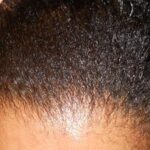Henna has a long history dating back to the Bronze Age and has been used to dye the hair, skin, and fingernails. Henna has been used tradiotnally also as a dye and preservative for leather and cloth. It is cultivated in India, Pakistan, Morrocco, Yemen, and other countries in this area. Thanks to improvments in cultivation and processing, Henna has had a revival of popularity. The U.S. FDA has approved henna for a hair dye, but it is illegal to use henna for body art. Henna that is shipped into the US as use for body art can be seized. Prosecution for using henna for body art rarely happens.
The body art is achieved by applying paste made from the dried and crushed leaves of the henna plant. A chemical, lawsone, bonds itself into the outer layer of skin, leaving a red-brown stain that becomes darker the longer the henna paste is kept in place. The powdered henna is usually mixed with a slightly acidic liquid such as lemon juice or tea. The paste is applied on the skin along a pattern after the paste has ‘rested’ for at least six hours. This allows the lawsone to develop properly enough to bond with the skin. Some preparations have tea tree oil, lavender oil, or eucalyptus oil to help improve the stain.
It takes some time for a very dark color to develop. The past can be left on for hours, the longer it is left on, the more intense the color result. The past will dry and flake during the time it is left on, so some artists apply a mix of lemon juice and sugar to the paste by dabbing it on. Others may add the sugar directly to the paste which may increase intensity of color as well. When the paste is removed, the stain will be orangish, but will darken over the next several days to a red-brown color. The soles of the feet and palms of the hands have the thickest layers of skin and will absorb the most henna stain. The stain here will be the darkest and last the longest.
Swimming may ruin the darkening process, as chlorinated water has been pointed to as a culprit in halting darkening. Once the stain has darkened to it’s full potential, it will look as if it is fading. This is not actually the case, it is just the skin being shed and as new skin cells come to the surface, they were not stained as much as the top. This will continue until all stained skin has been shed by the body.
Henna can be found in Indian or Middle Eatern grocery stores. Though if it has been packaged on a shelf for a very long time, it’s stregnth may have been lost and it will not stain as well as fresh henna. According to The Henna Page, a resource dedicated to the history and use of henna, many sellers of henna in India mix green dye into the henna powder to make it look more intense and desirable. This is known as ‘polishing’ the henna. A greener henna powder does promise better results in stain at all. The Henna Page, www.hennapage.com , gives directions on how to identify green dye in henna. Henna that is good quality and fresh may be wrapped and frozen, giving it years of lasting power.
Different henna artists use different mixes to make their henna release the dye in a way that makes them happy. Some may use tea, coffee, cloves, sugar, and lemon juice to mix into the henna. This is a typical mix, while other additives that are ‘sour’ can be used. Artists use a multitude of different liquids and methods of ‘cooking’ the additives to the preferred consistency. Most do bottle the liquid and reheat it before mixing into a paste.
Just as there are different mixtures of liquids to mix into the henna powder, there are many different ways to apply the henna. Most artists ‘pipe’ on the paste with a mylar cone which is made by rolling mylar squares into a cone, much like how bakers or confectioners use parchment paper to make piping bags for cake or pastry decorating. Some artists may also use what are commonly called ‘carrot bags’ in the henna art world. The bags are two mil piping bags that many people use to place candy in and place in easter baskets. They end up with a ‘carrot’ shape. Henna artists may cut a tiny hole in the end of the bag or use with different tips or couplers.
Once the henna has been placed in the bag, the artist will follow a pattern and pipe the henna paste along a pattern or freeform decorate the area to be henna painted. After the application has been finished the artist will ‘seal’ the henna so color will develop. Seals used are: pump hair gel, lemon/sugar mix, glue, peel of masques, liquid latex, and liquid bandage. The artist will then wrap the area and place a latex glove on the area if it is located on the hand. Hours later the wrappings will be removed, along with the paste, and the skin will have been stained.
Celebrities like Madonna, Prince, Justine Bateman, Gwen Stefani, and Liv Tyler have used henna instead of being tattooed. As a temporary alternative to tattoos, henna can be used by nearly anyone. Dyeing hair with henna can give highlights or color all of the hair bright red. It is recommended to do a strand test before covering all hair with the henna paste, as results can differ for each person. Henna for the hair will last around six weeks, whereas henna body are will last for a shorter period.
It is said that in ancient times, Queen Cleopatra used henna mixed with indigo to dye her hair a jet blue-black. To use henna for the hair, the following recipe may be used: mix one cup henna powder with one cup coffee or tea to make into a paste. Mixing in one egg or a tablespoon of castor oil will make the paste stick to the hair more readily. Heat the paste with a double boiler and let it steep for ten minutes or more, but no longer than an hour. Afterwards, add the egg or oil and using gloves, apply it to the hair while as hot as possible. Dry hair will absorb the color faster, resulting in a more intense red. Leave on the hair for forty minutes to three hours, then wash off.
Henna used on even the darkest hair will impart highlights that are visible in the sun. Even without a drastic color change, henna paste applied to hair will impart healthy properties. Hair will become stronger, shinier, and have more body with the useage of henna. When hair has been hennaed, it should not be permed or relaxed as the chemicals with cause a discoloration.
Natural henna rarely causes allergic reactions. Unlike the so called ‘black henna’ that is in circulation. Black henna is not henna at all, rather it is a black hair dye. The dye has a chemical base of para-phenylendiamine or PPD. This chemical is dangerous to use and in the US is illegal for use on skin. Even when used in hair dye, the levels must be below six percent. PPD causes allergic reactions, itching, blisters, and permanent scars. ‘Black henna’ pastes have a PPD level of ten to sixty percent and are left on the skin for half an hour, increasing the chances for damage. Blistering may not show up for three to twelve days after application. Once exposed to PPD and a sensitivity is triggered, the sensitivity is lifelong. A person who has this sensitivity may never use synthetic hair dye containing that chemical again because the results can be fatal. Natural henna may still be used as a hair dye, because black henna has no real henna in it.
Black henna may be found on websites, tourist areas, and some stores. It should be totally avoided.






